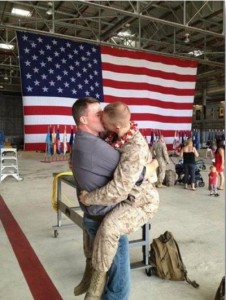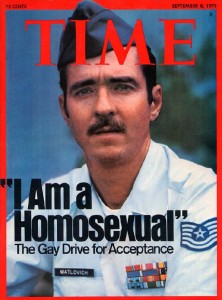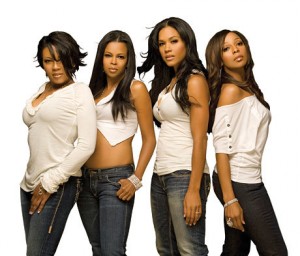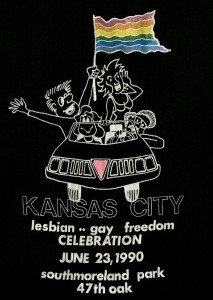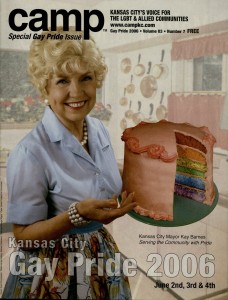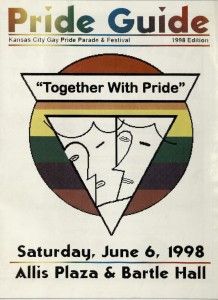Earlier this spring a rare image of Charlie Parker was discovered – it is the only known photograph of the jazz legend playing in Kansas City! Get the entire scoop in an article by Chuck Haddix, published in the latest issue of JAM Magazine: Bird-at-the-Jelly-Joint-JAM-2015-Aug-Sep-Oct
Author Archives: Stuart Hinds
40 Years of Pride – Part 22
So, why Pride? Hasn’t the LGBT community come so far that “Gay Pride” is unnecessary? Granted, the achievements made in the struggle for civil rights have been breathtaking as of late, especially, of course, in the push for same-sex marriage. But those accomplishments didn’t just happen. They were the result of decades of struggle by known and unknown individuals seeking a life without persecution based on who they were and demanding to be treated equally as any other citizen of this country. The fact that they achieved success is such a relatively short time is astounding. We celebrate Pride to celebrate them.
It is because of them that, in one lifetime, we went from this:
to this:
In one lifetime, from this:
to this:
In one lifetime, from this:

Del Martin and Phyllis Lyon, founders of the first lesbian advocacy group in the US. At their first meeting in 1955 they made sure that the curtains were drawn so they wouldn’t be seen from the outside.
to this:
That’s plenty to be proud of.
Happy Pride, Kansas City! Here’s to another 40 years!
40 Years of Pride – Part 21
So what do the next 40 years hold for Kansas City Pride Celebrations? Recent years have seen the development of Pride for specific populations within the LGBT community:
Whether these celebrations can be seen as positive or additional fracturing of the community is up for debate. But as we move toward what we hope will be additional civil rights accomplishments in a post-same-sex-marriage world, how will Pride be affected? Will we even need a Pride Celebration?
40 Years of Pride – Part 20
On this historic day in the struggle for LGBT rights, recall some of the important national figures in that battle who appeared at Kansas City Pride Celebrations. They, and many others like them, paved the way for the marriage equality decision handed down today :
Col. Margarethe Cammermeyer, at Pride in 1997
(photo courtesy C-Span)
Colonel Cammermeyer was the highest ranking military officer to be discharged because of her sexual orientation. Upon her discharge she sued, and won a victory in US District Court, enabling her to serve openly under “Don’t Ask, Don’t Tell”.
Technical Sgt. Leonard Matlovich, at Pride in 1978
Sergeant Matlovich received national attention as the first gay service member to purposely out himself to the military to fight its ban on gays.
Rev. Troy Perry, at Pride in 1979
Reverend Perry founded the Metropolitan Christian Church in 1968. Kansas City’s chapter was formed five years later.
40 Years of Pride, Part 19
40 Years of Pride – Part 18
As local Pride Celebrations became more commercial over the years, a wide variety of notable musical acts have performed at them. Here is a sample:
40 Years of Pride – Part 17
In the last 40 years, Kansas City’s Pride Celebrations have been held throughout the city. Here’s a list of most of those venues:
1975: Gay Community House, 3825 Virginia
1978, 1979, 1994, 2004-2009: Penn Valley Park/Liberty Memorial
1988-92: Southmoreland Park
1993: Roanoke Park
1995-2003: Barney Allis Plaza
2010, 2015: Berkley Riverfront Park
2011-2012: Power and Light District
2013: Westport
2014: West Bottoms
Of course, it wouldn’t be a festival without a t-shirt, so here are the logos from a random assortment of Pride Celebrations:
40 Years of Pride – Part 16
By the 2000-teens, Pride Celebrations in Kansas City were on the decline. Perceived focus towards a target market group rather than the entire community, uneven production values, and ongoing concern around fiscal responsibilities have all contributed to a sense of frustration and apathy about Pride. Indeed, there have been attempts at offering what some might consider competing Pride events. For these reasons, this 40th anniversary year brought a new emphasis on improvements to the Celebration, resulting in the largest crowds of the decade so far.
40 Years of Pride – Part 15
The trend towards making a profit from the Pride Celebration that started in the 1990s continued into the new century. Various entities were formed to manage production of the event, some with greater success than others. Pride Celebrations in Kansas City during this time were plagued with real or perceived financial malfeasance, which soured the event for many.
The scale of the events, however, continued to benefit from the influx of funds and grew as the decade progressed. The location was shifted from Barney Allis Plaza to Penn Valley Park, which could accommodate more attendees, more vendors, and a larger stage for entertainment. Several years saw a Street Festival in what is now the Crossroads District prior to the weekend’s main events in the park. Exhibitor booths expanded to include a much greater percentage of commercial vendors, further contributing to the move towards a greater corporate feel to the Celebration. Marketing seemed to be a goal, not community-building.
Support from politicians for the LGBT community and its concerns was another facet of the Pride Celebrations that expanded during this time as well. Proclamations for Pride were regularly issued by city, county, and state leaders. But nowhere was this support made more memorable than the cover of the June, 2006 issue of Camp, Kansas City’s primary LGBT news periodical. Mayor Kay Barnes, a longtime supporter of the LGBT community, appeared in a blond wig and 1950s housewife garb holding a iced rainbow cake:
It was a masterful and unforgettable depiction of growing political support for Kansas City’s LGBT communities.
40 Years of Pride – Part 14
The mid- to late-1990s saw a shift in the evolution of Kansas City’s Pride Celebrations. Organizers noted the size of crowds in attendance, and realized that the Celebrations could turn a profit if presented appropriately. The first evidence of this transformation in GLAMA collections is in 1996. While the Celebration was presented for the second year by Project Pride, a new initiative of GLSN, it appears to have been the first time a fee was levied on attendees. The one-day festival was held at Barney Allis Plaza in downtown Kansas City, preceded by a parade.
By 1998, a for-profit corporation was responsible for the Pride Celebration, again held in Barney Allis Plaza with an accompanying parade and admission fee. In 10 years, Kansas City’s Pride Celebration has gone from a grassroots, community-driven effort to a profit-driven event.



